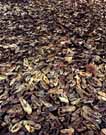
|
|
|

|

|

|

|
|
Click on an image to see a larger, more detailed picture.
|
|
|
|
|
| 1943: Death and Resistance |

|
pg. 479 |

|
|
|
|
| |
 Human skeletons cover the ground outside the crematorium at the Majdanek camp in Poland. Approximately 145,000 people died in the seven gas chambers, which began operating, utilizing Zyklon B, in 1942. Many others died from starvation, dysentery, or shootings. The small crematorium proved inca-pable of handling the great influx of bodies, and so a large new one was constructed in September 1943.
Human skeletons cover the ground outside the crematorium at the Majdanek camp in Poland. Approximately 145,000 people died in the seven gas chambers, which began operating, utilizing Zyklon B, in 1942. Many others died from starvation, dysentery, or shootings. The small crematorium proved inca-pable of handling the great influx of bodies, and so a large new one was constructed in September 1943.
Photo: SYddeutscher Verlag Bilderdienst
|
 This mountain of shoes at the Majdanek death camp testifies to the number of people who walked through the gates of the camp to their deaths. While prisoners hobbled in ill-fitting clogs, tons of shoes accumulated in the storerooms of the death camps. At Auschwitz-Birkenau, women were assigned to the Schuhkommando. They performed tedious labor, separating soles from uppers and rubber from leather, with the pieces shipped to Germany. One woman, Giuliani Tedeschi, described the work as "drowning in a sea of shoes."
This mountain of shoes at the Majdanek death camp testifies to the number of people who walked through the gates of the camp to their deaths. While prisoners hobbled in ill-fitting clogs, tons of shoes accumulated in the storerooms of the death camps. At Auschwitz-Birkenau, women were assigned to the Schuhkommando. They performed tedious labor, separating soles from uppers and rubber from leather, with the pieces shipped to Germany. One woman, Giuliani Tedeschi, described the work as "drowning in a sea of shoes."
Photo: Arnold Kramer / United States Holocaust Memorial Museum Photo Archive
|
 Majdanek
Majdanek
Majdanek, a concentration and death camp near Lublin, Poland, became operational in October 1941. Before Soviet troops liberated the camp on July 24, 1944, nearly 500,000 persons from 28 countries were imprisoned there. Majdanek's death toll reached 360,000--mostly Soviet POWs, Poles, and Jews. Sixty percent died from starvation, disease, and exhausting labor. The others were executed, often on arrival. Those victims included thousands of Jews who were murdered in Majdanek's seven gas chambers. In late October 1943, prisoners were ordered to dig three huge trenches in the camp's southern sector. These preparations were for Erntefest (Harvest Festival). At Majdanek's morning roll call on November 3, Jews were separated from the other prisoners, sent to the trenches, and shot. Dance music blared from the camp's loudspeakers to drown out the screams and machine-gun fire. The murders continued until nightfall. "Bloody Wednesday" left 18,000 Jews dead in Majdanek's trenches. Intended to prevent Jewish prisoner revolts, Erntefest went beyond Majdanek. Jewish prisoners at other camps in the Lublin district--8000 to 10,000 at Trawniki and 15,000 at Poniatowa--also were shot on November 3. It remained Majdanek's distinction, however, to be the most deadly site of the Germans' largest one-day killing operation against the Jews.
Photo: Bilderdienst SYddeutscher Verlag
|
|

|

|

|

|
 September 10, 1943: Germans occupy Rome.
September 10, 1943: Germans occupy Rome.
|
 September 11, 1943: One thousand Jews discovered hiding in Przemysl, Poland, are murdered.
September 11, 1943: One thousand Jews discovered hiding in Przemysl, Poland, are murdered.
|
 September 11-14, 1943: The Jewish community at Minsk, Belorussia, is liquidated.
September 11-14, 1943: The Jewish community at Minsk, Belorussia, is liquidated.
|
 September 13, 1943: In the Lódz (Poland) Ghetto, Icek Bekerman is hanged for taking leather scraps for use as shoelaces. The ghetto carpentry shop is ordered to construct the gallows.
September 13, 1943: In the Lódz (Poland) Ghetto, Icek Bekerman is hanged for taking leather scraps for use as shoelaces. The ghetto carpentry shop is ordered to construct the gallows.
|
 September 14, 1943: Jacob Gens, Judenrat leader at the Vilna (Lithuania) Ghetto, is shot by Nazis.
September 14, 1943: Jacob Gens, Judenrat leader at the Vilna (Lithuania) Ghetto, is shot by Nazis.
|
 Mid-September 1943: At the Sobibór death camp, members of the corpse-burning detail have built an escape tunnel intended to lead them into the camp minefield. Most of the 150 members of the detail are killed.
Mid-September 1943: At the Sobibór death camp, members of the corpse-burning detail have built an escape tunnel intended to lead them into the camp minefield. Most of the 150 members of the detail are killed.
|
|
|
|
|
| 1943: Death and Resistance |

|
pg. 479 |

|
|
The Holocaust Chronicle
© 2009 Publications International, Ltd.
|
|
